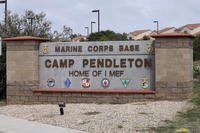A year apart, on the same turnoff from "Route Pluto" in Baghdad, Army Capt. Sean English was killed and Army PFC Robert Bartlett was severely wounded by the high-powered devices known as "Explosively Formed Penetrators (EFPs)" supplied by Iran to terror proxies.
Tricia English, the widow of Capt. English, and Bartlett were among more than 100 veterans and Gold Star families who joined in a lawsuit -- Karcher et al v. Islamic Republic of Iran -- that went to trial this week in federal court.
Neither English nor Bartlett said Friday that they expected much, if any, compensation to result from the suit -- but that was not the point.
"We want to hold people accountable who have done this to our families," Tricia English said Friday at a National Press Club news conference.
"This is not about money for me. First and foremost, this is not about compensation," said Bartlett, 45, who has lived in several places in Arizona.
He said the suit would be worth the lengthy effort to bring it to trial "if it stops one person from getting killed and highlights what the Iranian regime has done to destabilize the region."
Judge Colleen Kollar-Kotelly in U.S. District Court for the District of Columbia this week heard three days of testimony from families, victims and experts, and took into the trial record reams of declassified documents and physical evidence of the EFPs to show Iran's complicity.
Kollar-Kotelly had ruled last year that Iran was properly served on the suit, but the Iranian regime, which does not recognize the jurisdiction of the court, was not represented at the trial, which Korral-Kotelly heard without a jury.
Gary M. Osen, managing partner of Osen LLC, the Hackensack, New Jersey, law firm for the plaintiffs, said Kollar-Kotelly was expected to issue a verdict, possibly by next summer, which could result in a default judgment against Iran.
The next likely step would be to pursue damages under the terrorism exception to the Foreign Sovereign Immunities Act, which has been used previously to sue state sponsors of terrorism, he said.
The lawsuit has been described as seeking $10 billion damages, but Osen said Friday that he didn't know where that number came from.
At the news conference Friday, Dr. Shean Eric Phelps, a former Army Green Beret combat medic and later an Air Force flight surgeon, spoke to the devastating effects of the EFPs.
As opposed to the crude roadside bombs, or Improvised Explosive Devices, that also took a heavy toll on U.S. troops, the EFPs were carefully designed and manufactured for maximum impact, and were set off by PITs, or Passive Infrared Triggers, which served as motion detectors, Phelps said. The U.S. never developed a counter-measure, Phelps said.
"It takes a level of sophistication only seen in advanced technology," Phelps said of the EFPs. The devices shredded the U.S. up-armored Humvees and the MRAPs, or Mine Resistant Ambush Protected vehicles, which replaced them.
The thickness of the armor offered little defense against them, he said. "It pretty much goes through anything known to man" by sending out penetrator slugs and a copper shaped charge at speeds of more than 4,800 mph, Phelps said.
The effect was that "the armor of the Humvee becomes part of the weapon -- it turns the armor into a blender," he said.
Osen said the weapons were developed by the "tradecraft" of the Lebanese Hezbollah and manufactured by Iran. He attributed the distribution to terrorists in Iraq directly to Qasem Suleimani, a major general in the Iran's Islamic Revolutionary Guard Corps (IRGC) and commander of the IRGC's Quds Force.
In May 2005, Robert Bartlett said he was on a presence and reconnaissance patrol of up-armored Humvees and was making the turn off Route Pluto to a street known as Brewers road when an EFP tore into his vehicle.
Staff Sgt. William Brooks was killed and Cpl. Todd Bishop lost his legs. Bartlett would undergo five years of surgeries and rehabilitation at Walter Reed Army Medical Center.
"It's actually a miracle I'm at this table with you," he said.
Tricia English said her husband's vehicle was making the same turn onto Brewers road in December 2006. "He was in the passenger's seat. They took a direct hit from an EFP. Sean was the only casualty," she said.
She noted that he died on Dec. 3, 2006, 12 years to the day that the trial started in Kollar-Kotelly's court.
English, of Columbus, Ohio, said she had to go back-and-forth with the Department of Veterans Affairs before she was permitted to have one of his favorite sayings engraved on the headstone: "Do the harder right over the easier wrong."
-- Richard Sisk can be reached at Richard.Sisk@Military.com.












